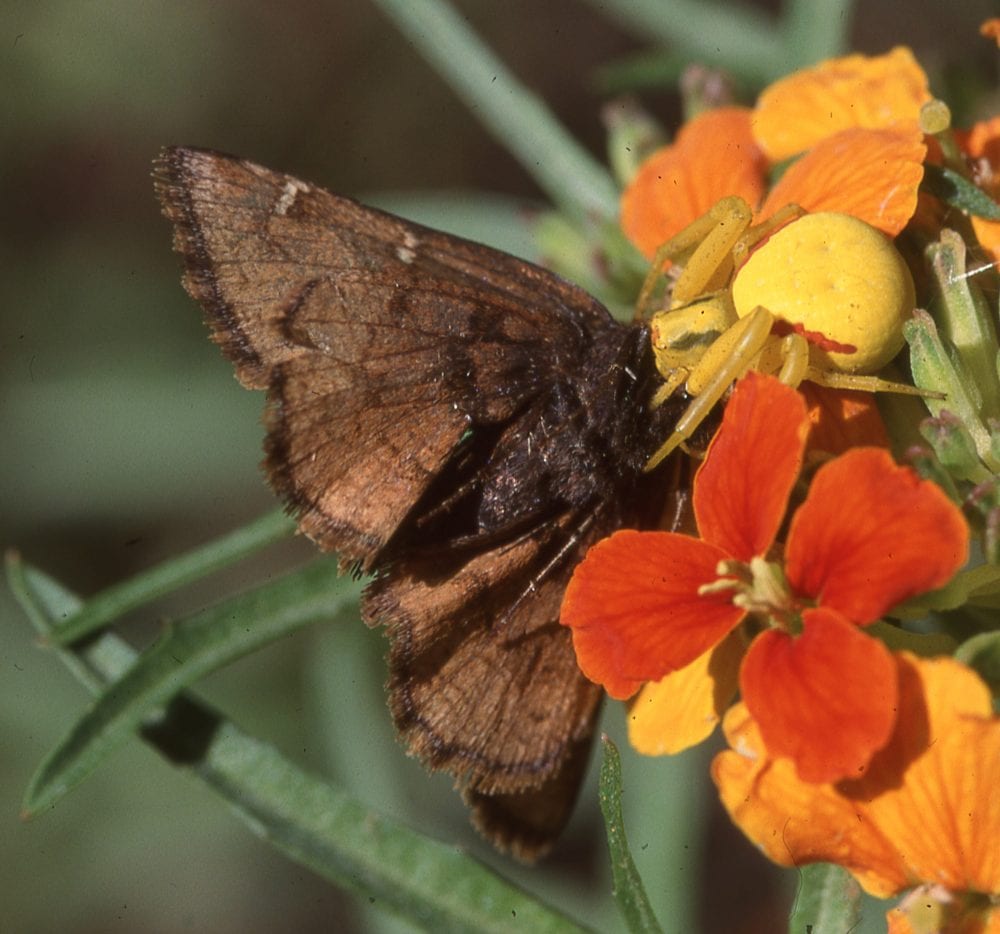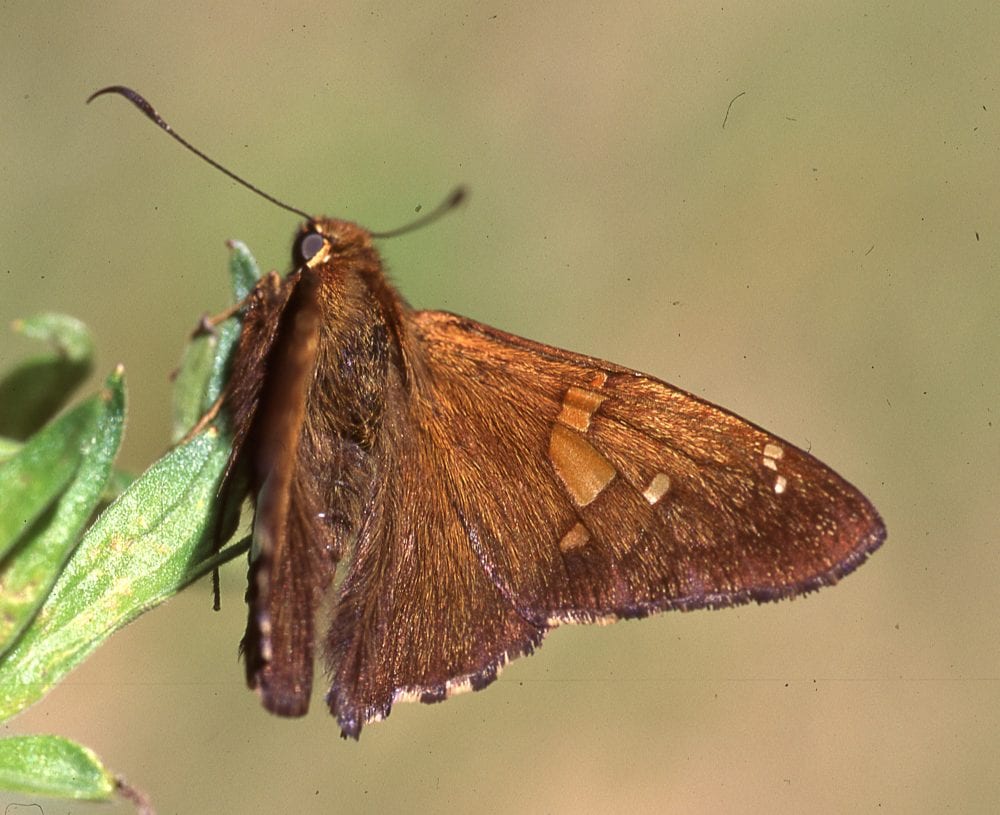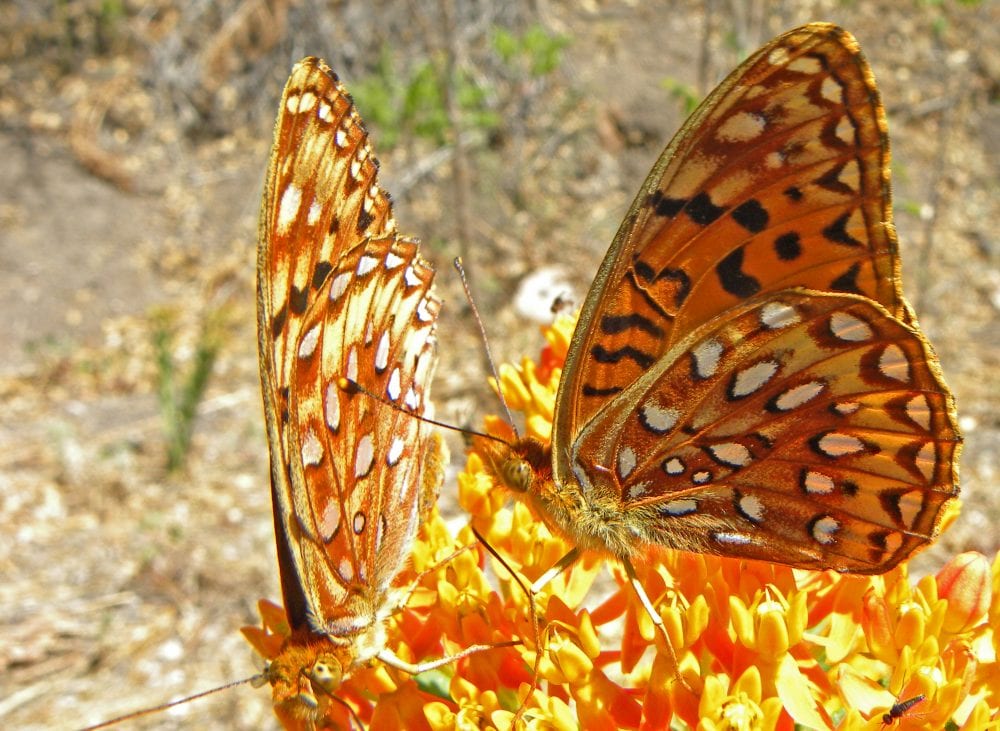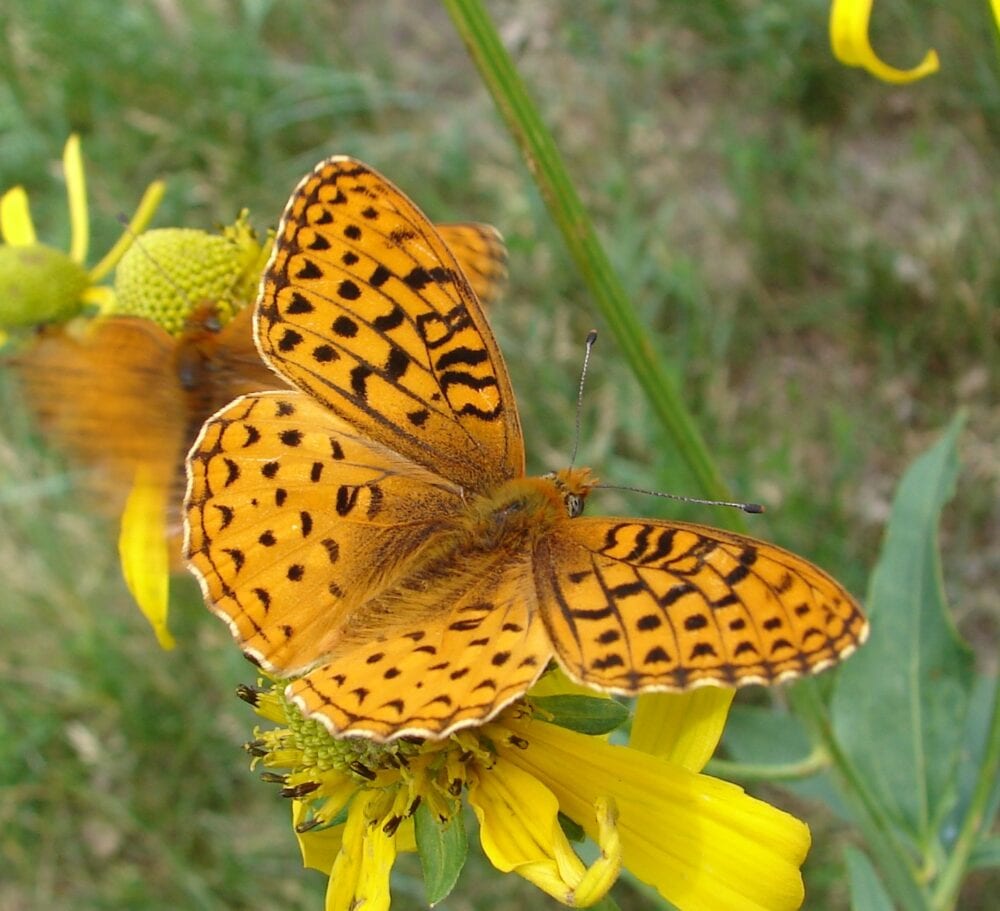December 20, 2020
By Steven J. Cary
But first, the news. Butterflies of New Mexico has received some important updates. For example, excellent photographs by Albuquerque’s Stephanie Dzur have been added to species accounts for Monarch, Queen and Painted Lady. Second, I uploaded a recent Rob Wu photograph of a Common or White Checkered-Skipper that is a bilateral gynandromorph: male on the left, female on the right. These are quite unusual in any species, so check it out. Finally, accomplished nature photographer Bryan Reynolds has generously contributed dozens of his superb butterfly images, thus elevating the overall quality of the book. Stay tuned for future blog posts relating Bryan’s butterfly photography adventures in New Mexico.
In the biological realm of taxonomy, the principal goal always has been to accurately characterize relationships and boundaries between organisms. DNA analysis is an astounding and evolving new armory being put to that use. In the formative days of DNA studies, taxonomists parsed and compared organisms on the basis of only a few genes, hoping to add a useful tool to the task of identifying species and subspecies. That was when I went to sleep on DNA work. Today, DNA studies have progressed and scientists are sequencing and comparing entire genomes. To my way of thinking, that is a game-changer. Now I am awake.
For butterflies, much of this work is being conducted in what is popularly called (Dr.) Nick Grishin’s (molecular biochemistry) lab in Dallas and is supported by (Dr.) Paul Opler of the Gillette Arthropod Museum at Colorado State University in Fort Collins. Using this genomics approach, that group recently published yet another paper (Zhang et al., 2020) that reorganizes and renames still more North American butterflies. Though I consider myself woefully ignorant on this subject, I found this work to be wonderfully lucid and enjoyable to read.
For New Mexico butterflies and butterflyers, Zhang et al. revealed several distinct species which had passed unrecognized due to their close resemblance to other species. The new creatures include: Argynnis nausicaa (Southwestern Fritillary), Chlosyne chinatiensis (Trans-Pecos Checkerspot), Epargyreus huachuca (Huachuca Skipper), Cecropterus nevada (Nevada Cloudywing) and Cecropterus dobra (Dobra Skipper). I summarize each below, in reverse order. PEEC’s Butterflies of New Mexico has been updated to incorporate these recent taxonomy and name changes.
Nevada Cloudywing (Cecropterus nevada) and Dobra Cloudywing (Cecropterus dobra)
New Mexico’s higher mountains are home to a non-showy skipper which for some time we have been calling Mexican Cloudywing (Thorybes mexicana). Northern New Mexico has had subspecies nevada while subspecies dobra could be found farther south in the Gila high country and the Sierra Blanca complex. Zhang et al. determined that (1) Thorybes is best considered a subgenus of Cecropterus and (2) dobra and nevada is each a full species, which we can call Cecropterus dobra and Cecropterus nevada. English names have not been assigned as yet, but Dobra Cloudywing and Nevada Cloudywing seem like comfortable placeholders. The two new species will be hard to distinguish from each other based on wing characters alone, but we can rely on location as a key diagnostic factor until we figure out the markings.

Huachuca Skipper (Epargyreus huachuca)
Silver-spotted Skippers (Epargyreus clarus) are large, brightly marked and easily recognized in our mountains. We have treated those in northern New Mexico as Epargyreus clarus clarus, the nominate subspecies typical of the eastern US. Those in southern New Mexico and adjacent southern Arizona have been Epargyreus clarus huachuca, whose forewing gold band has a detached spot. Zhang et al. determined that huachuca is actually a full species, so henceforth we will call it Epargyreus huachuca, and perhaps Huachuca Skipper. Look for it in the Sacramentos, Black Range, and Gila high country. Can you find the detached gold spot in the photo below?

Trans-Pecos Checkerspot (Chlosyne chinatiensis)
Over the years, experts have wavered on whether this distinctive checkerspot, initially described from the Chinati Mountains of Trans-Pecos Texas, was its own species or merely a local variant, or subspecies, of the widespread and variable Theona Checkerspot (Chlosyne theona), which is routinely encountered in our southern tier of counties. The chinatiensis phenotype (see below) rarely appears in New Mexico. Now Zhang et al. have determined that it is a distinct species: Chlosyne chinatiensis. Trans-Pecos Checkerspot would be an appropriate English name.

For each of the above butterflies, the issue — are they distinct species or merely two subspecies of one species — comes down to how different they are, which is determined by how long ago they were reproductively isolated from each other. In the past, answering that question was constrained by what we could see with our eyes. For many creatures, the matter of species vs subspecies has seen a decadal ebbing and flowing of scientific opinion, incorporating new evidence as it comes available. Now, the evolving DNA approach to the question may be producing a measurable numeric threshold of how different the DNA has to be. Exceed a particular quantifiable amount and the flashing light says “distinct species,” though there may be some judgment in that as well.
One reaction to that quantitative approach is rather old fashioned, I know, but pardon me . . . has anyone checked to see if these two creatures are willing and able to interbreed and produce viable, fertile offspring? DNA analysts are not deaf to that and other larger questions. In fact, Zhang et al. assert that “the genotype encodes phenotype, thus, all the features of wing patterns and morphology of butterflies and their life stages (including caterpillar foodplant preferences) are encoded in these genomic sequences. For this reason, the genomic dataset we sequence may be the best representation of a butterfly (richer than a pinned adult specimen that we visually inspect), given a meaningful approach to analyze these genomes.” Point taken.
Data and argument will continue to wax and wane on the issue of species vs. subspecies. Zhang et al. submit a new round of evidence, with thoughtful interpretations and meaningful conclusions. As one possible analytical weakness, those authors used only one specimen for each taxon. Granted it was a type specimen and that approach certainly planted genomic flags for all the taxa involved, as was their intent. Population level studies for each taxon, when conducted, would more fully flesh out the genome for each. Then more discussion can take place.
Southwestern Fritillary (Argynnis nausicaa)
More significant than the above promotions of subspecies to full species is Zhang et al.’s discernment of a “new” species from a hemisphere-wide blizzard of named forms. After decades of wandering in the nomenclatural wilderness, several of New Mexico’s fritillary populations have a new taxonomic identity as a full species — Argynnis nausicaa (see below). And here is my unofficial English name for it: Southwestern Fritillary. Those of you attuned to Latin names will wonder why the new frit is not Speyeria nausicaa, but rather than have that discussion here, please consult Zhang et al., who offer a straightforward explanation. Below I focus on the species and subspecies levels of analysis and discussion for this butterfly.

Each of New Mexico’s large mountain ranges is home to one or more scientifically recognized, Latin-named, silver-spotted fritillaries, now back in the Old World genus Argynnis. In the chronological order in which they were discovered and named, they are: (1) nausicaa W. H. Edwards (1874) from Arizona’s Mt. Graham, but also the Mogollon Rim and Gila high country; (2) electa W. H. Edwards (1878) from Colorado and the Sangre de Cristo Mountains; (3) nikias Ehrmann (1917) from our Jemez Mountains; (4) dorothea Moeck (1947) from the Sandia Mountains, Magdalenas, Mt. Taylor and Chuskas; (5) ratonensis J. A. Scott (1981) from our Raton Mesa complex; and (6) capitanensis R. Holland (1988) from the Sacramento, Sierra Blanca and Capitan ranges of south-central New Mexico. These six summer-flying, flower-visiting fritillaries are visually prominent members of their local butterfly faunas.
Each of the first four taxa was originally described as its own species, but later workers in the complicated Argynnis (Speyeria) fritillary universe relegated them to subspecies of other species, as seemed reasonable then. Forty years ago, those first four were part of a 21-subspecies assemblage nestled under Atlantis Fritillary, Argynnis (Speyeria) atlantis W. H. Edwards 1862 (Miller and Brown 1981). Upon their description in 1981 and 1988 respectively, subspecies ratonensis and capitanensis were added to A. atlantis. When I entered the New Mexico butterfly world c. 1980, I learned these six fritillaries as local forms of Atlantis.
Two decades later, after more research, Scott (1998) shifted those six (plus others) from Atlantis Fritillary over to Northwestern Fritillary, Argynnis (Speyeria) hesperis W. H. Edwards 1864, where they retained subspecies status. That adjustment took some getting used to and was not embraced immediately by everyone. I don’t know about you, but I take comfort in believing I know things, however uninformed and misguided that belief may be, and it is awkward and discomfiting to have to change my brain. I resisted, but subsequent field guides adopted the new perspective and I did, too. I got my revenge by taking secret glee in calling A. (S.) hesperis nausicaa the ‘Southwestern’ Northwestern Fritillary.
Meanwhile, differences within this sprawling complex of similar creatures continued to cause head-scratching, in and out of New Mexico. Jeff Glassberg, for example, pointed to eye color differences among the fritillaries. Nokomis, Great Spangled and Aphrodite all have tan/brown/amber eyes, while all the others in northern New Mexico, notably erstwhile Northwestern races ratonensis, electa and nikias, have gray/blue eyes. Eye color became a diagnostic crutch for me when wing characters were unclear. However, when I explored farther south I saw that fritillaries in the Sandias, Manzanos, Capitans, Sacramentos, and Gila country, all purported Northwestern races, had tan/amber eyes, not the blue/gray eyes of their sisters living in my neighborhood. No one really knows what eye color might mean within the Argynnis world, but Glassberg (2012) suggested that these (mostly) brown-eyed races of Arizona and southern and central New Mexico might someday merit their own species.
Was Jeff prophetic? Did he have a mole on the inside? Zhang et al. did a genomic analysis using DNA from type specimens representing more than 60 named fritillary taxa in this atlantis-hesperis complex. Those authors concluded that southwestern subspecies nausicaa, electa, dorothea and capitanensis had DNA that grouped them together with each other and not with Agynnis hesperis or Argynnis atlantis. This newly recognized species needed a Latin name and by rule that honor goes to the oldest type in the group and thus Argynnis nausicaa was reinstated as the full species William Henry Edwards envisioned when he described it in 1874. Subspecies electa, capitanensis and dorothea, after being subordinates of Argynnis hesperis and Argynnis atlantis, are now subspecies of Argynnis nausicaa. Until an English name is officially chosen for this creature, why not call it Southwestern Fritillary? Other western subspecies whose DNA clusters with nausicaa stretch from Utah and Nevada to Idaho, Montana, Wyoming, and Colorado, making it an insect not just of the Southwest, but of the greater Intermountain West. Those ones up there in Idaho and Montana can be ‘Northwestern’ Southwestern Fritillaries.
It seems that nikias, which was described from the Jemez Mountains, was not included in the genomic analysis, leaving its status up in the air. I believe Colorado’s Mike Fisher leans toward including Jemez Mountains nikias as a junior synonym of electa and I can find no reason other than turfiness to disagree, so perhaps it is reasonable to place it under A. nausicaa along with electa.
Raton Mesa Fritillary (Argynnis hesperis ratonensis)
And where did the Raton Mesa Fritillary shake out in this genomic analysis? It turns out that ratonensis aggregated with Argynnis hesperis, not Argynnis nausicaa, Argynnis atlantis or anything else. That means we still have Northwestern Fritillary in New Mexico, but only in the form of Raton Mesa Fritillary. I like that. To me, that insect has always seemed different from the other fritillaries that now rest under the umbrella of Argynnis nausicaa. I am glad it remains apart from them and connected instead to other Northwestern Fritillary subspecies, which array themselves northward along the High Plains to the Dakotas and Canadian prairie provinces thence west to Washington and British Columbia. This gives us a net addition of one fritillary species to the New Mexico fauna.

Isn’t that a nice hatful of species to add to New Mexico’s butterfly fauna? Granted, the paper by Zhang et al. will be scrutinized by other scientists and it is not clear which of the taxonomic changes will stand the test of time. Some of those authors’ decisions are close to being judgment calls and those can fall either way depending on who is doing the judging. For now, I like to think that more clarity has been offered for some of our messier butterfly entities. A good project for New Mexico butterflyers in coming years might be to seek out these new creatures and add them to our New Mexico butterfly experiences.
Glassberg, Jeffrey. 2012. A Swift Guide to Butterflies of North America. Sunstreak Books, Inc. 416 pp.
Miller, L.D., and F.M. Brown. 1981. A catalogue/checklist of the butterflies of America north of Mexico. Lepidopterists’ Society Memoir 2:i–vii, 1–280.
Scott, James A. 1998. New western North American butterflies. Papilio, New Series 11:1-2.
Jing Zhang, Qian Cong, Jinhui Shen, Paul A. Opler and Nick V. Grishin. Nov. 6, 2020. Genomic evidence suggests further changes of butterfly names. The Taxonomic Report of The International Lepidoptera Survey 8(7): 41 pp. ISSN 2643-4776 (print) / ISSN 2643-4806 (online)

Happy New Year Nice integrated analysis Steve!, Paul Opler
It will be interesting to see how the recent proposed name changes stand the test of time. Already, many North American lepidopterists have realized the use of Cecropterus instead of Thorybes is not necessary, and in fact obscures relationships by creating a non-diagnosable “catch-all” genus Cecropterus. Maintaining use of Thorybes is completely justifiable based on evidence presented in Zhang et al. As for the split between nevada and dobra- until a lot of material from New Mexico can be sequenced, this split is really just hypothetical- much more study is needed on this, especially in New Mexico. The situation around Argynnis hesperis-nausicaa is complicated, and the recent genomic analyses did not include important populations that are intermediate between electa and hesperis-ratonensis. Additional, localized studies where nausicaa ssp. come into contact with hesperus ssp. will be needed before much confidence can be placed in the new proposed division into two species. Many of the new changes proposed by Zhang et al. are based on arbitrary genetic distance thresholds, which assume uniform rates of evolution, so are not entirely satisfactory without additional corroborating evidence from morphology or ecology. As for Epargyreus huachuca, George Austin was treating this as a full species at the time of his passing in 2010, in the manuscript to his Butterflies of Nevada, based on genitalic differences between it and clarus, so this split, at least, seems justified.